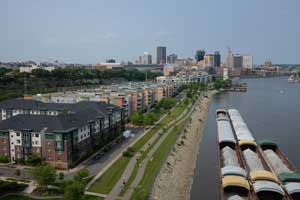Sustainable Stewardship

Infrastructure investment
Together the region aligns development patterns and highway investments by focusing growth and investment along corridors with strong potential for transit or managed lanes. Areas outside these corridors may continue to develop but will receive limited investments from federal or state sources for new or expanded highways. This places a focus on operating and maintaining the current highway system, while allowing support for a network of transitways, and strong biking and walking systems.
Housing
Greater housing options, including denser and more mixed-use development near jobs and activities, should be cost-effectively supported by highways, streets, transit, bicycling, and walking to create more livable communities where the market demands them. Communities can also identify local centers to emphasize for this type of development. To correspond, local governments should plan for higher intensity land use near transitways:
- Transit-oriented development, a mix of housing choices, retail, and other commercial uses around station areas.
- Communities designed for biking and walking, where residents can choose to use their car less (or not at all) to shop, travel to transit, and get to work, school and recreation areas.
- Housing and commercial developments that are denser to create more successful and efficient transit service areas, including providing more transit service.
- A mix of housing choices, including affordable options near transit to accommodate youth, the elderly, and populations looking for an alternative to driving.
Freight
Our highway, railroad, river, and aviation systems will continue to be the foundation for freight movements important to our region’s overall prosperity. Freight infrastructure and land use − particularly riverfront and rail-accessible facilities − can be difficult and expensive to reestablish.
Aviation
Just as with freight-related land uses and infrastructure, the region’s airports are important to the flow of commerce and people. Communities, businesses, and aviation stakeholders should collaborate to:
- Limit residential and other incompatible land use encroachment near airports
- Limit negative impacts on adjacent communities including noise